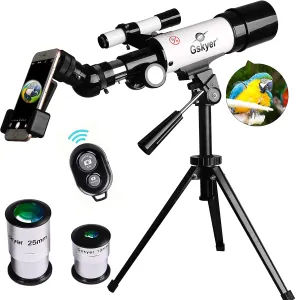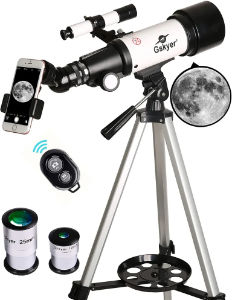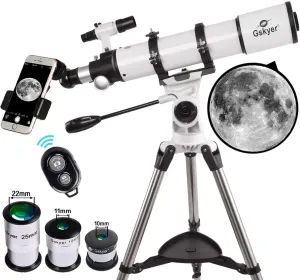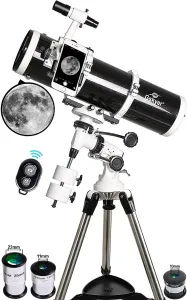Gskyer makes several different telescopes and finding the right one for your needs may be a little difficult. Below is some information that will hopefully help you on your quest.
Table of Contents
Gskyer Telescope Comparison Chart
| Image | Product | Details | Price |
|---|---|---|---|
 | Gskyer Telescope AZ60350 | Objective Lens: 60m Focal Length: 350mm Item Weight: 3.48 pounds | Check NewCheck Used |
 | Gskyer Telescope AZ70400 | Objective Lens: 70mm Focal Length: 400mm Item Weight: 5.81 Pounds | Check NewCheck Used |
 | Gskyer Telescope AZ80400 | Objective Lens: 80mm Focal Length: 400mm Item Weight: 17.46 pounds | Check NewCheck Used |
 | Gskyer Telescope AZ90600 | Objective Lens: 90mm Focal Length: 600mm Item Weight: 18 Pounds | Check NewCheck Used |
 | Gskyer Telescope 130EQ | Objective Lens: 130mm Focal Length: 650mm Item Weight: 30.1 pounds | Check NewCheck Used |
Which Gskyer telescope is best for kids?
This depends on what they will be doing, what age they are, and how serious you think they are with astronomy.
The AZ70400 would be the best choice for small children, those who may not really be interested in astronomy that much. This is the telescope that you buy when you are not sure as the investment is not that much. It is also very nice to throw in the back of the car for trips as it is very useful during the day.
The larger AZ80400 would be better suited for kids who have some more interest in astronomy, who are maybe a little older, and can take care of expensive equipment. It will provide better views, more stability, and last a little longer before someone really interested in astronomy wants to upgrade.
The largest refractor, the AZ90600, is my recommendation as a first telescope for kids who are in their teens and show a serious interest in astronomy. This 90mm refractor will provide superior views, be much more stable, and probably last much longer before that inevitable upgrade.
Which Gskyer telescope is best for adults?
Even when dealing with adults, the question of what the telescope will be used for is of prime importance. Age is certainly a factor, but it is not usually the most critical.
If you are looking for something to use terrestrially (on the planet, objects at a distance such as animals, ships, etc) then the AZ70400 might be fine. If you ever plan to point your telescope towards the sky, I would avoid it.
The 80mm AZ80400 is the bare minimum. It will provide better views and more stability than its 70mm little brother. It is your best choice for a portable telescope that will be used both on earth as well as pointing to the sky. If portability is not a concern, then continue reading on.
Up next are Gskyer’s two top telescopes, the 130EQ Newtonian reflector, and the AZ90600 refractor. These are the two most advanced telescopes that Gskyer currently offers and both are much better than the smaller refractors we have already converted.
Looking at the 130EQ, it absolutely will allow you to see the most objects, no questions. That comes at a tradeoff of much longer setup time, having to collimate it often, a steeper learning curve, and long cool-down times before you can really start observing.
On the other hand, the AZ90600 90mm refractor will still give you a good selection of celestial objects to see while being very fast and easy to set up and use.
So it really comes down to whether you are someone who prefers to get out and quickly start viewing objects (AZ90600), or someone who wants to see the most number of objects and get the absolute best views of those objects you can get (130EQ).